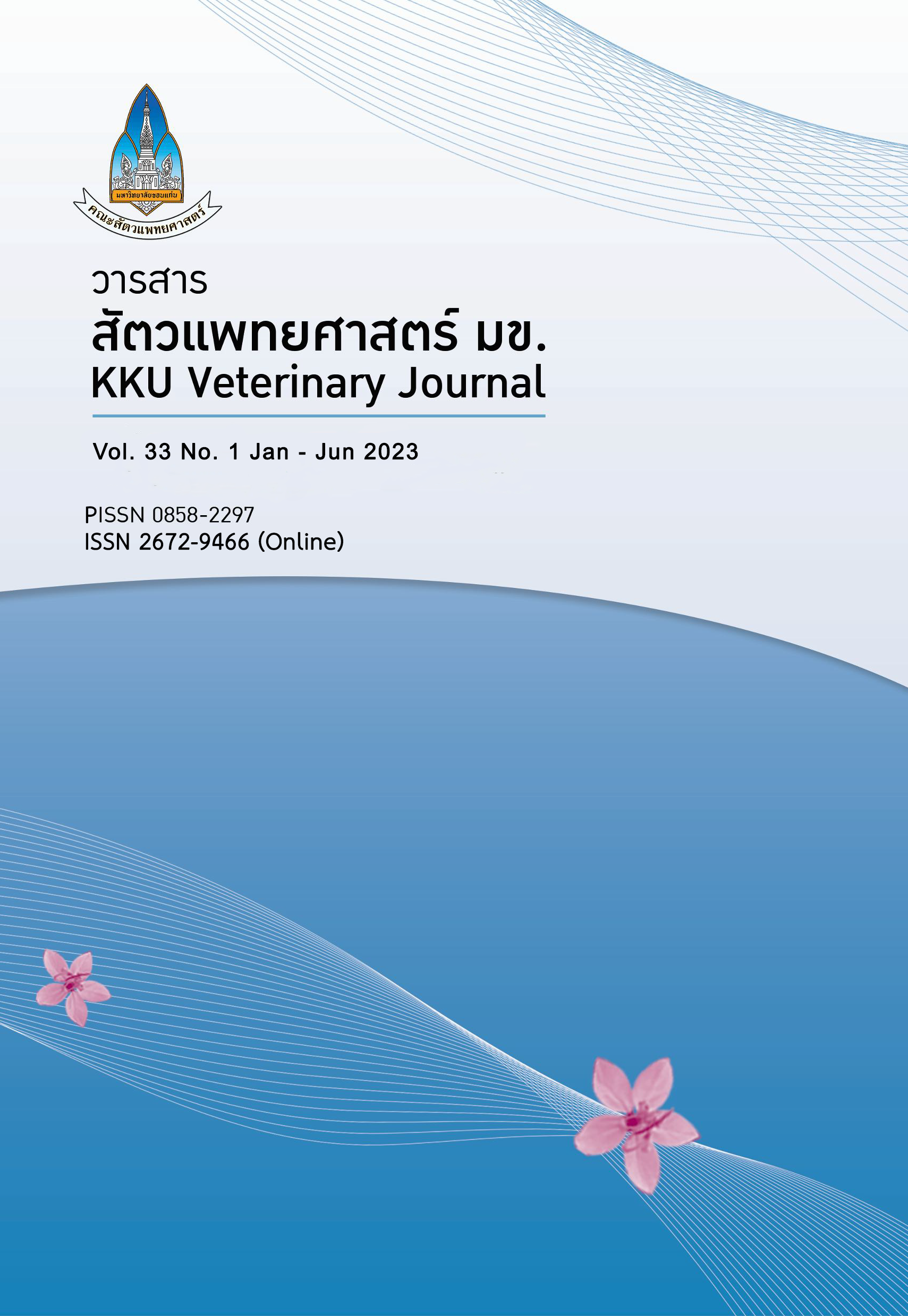การศึกษาเปรียบเทียบการใช้ชุดตรวจสำเร็จรูปและเทคนิคปฏิกิริยาลูกโซ่พอลิเมอเรส (พีซีอาร์)ในการวินิจฉัยโรคที่มีเห็บเป็นพาหะของสุนัขและความสัมพันธ์ของอาการทางคลินิกและค่าโลหิตวิทยาในจังหวัดชลบุรี
Main Article Content
บทคัดย่อ
วัตถุประสงค์ เพื่อศึกษาเปรียบเทียบผลการตรวจวินิจฉัยโรคที่มีเห็บเป็นพาหะในสุนัขจากชุดตรวจสำเร็จรูปและเทคนิค PCR และหาความสัมพันธ์กับอาการทางคลินิกและค่าโลหิตวิทยาที่สำคัญ
วัสดุ อุปกรณ์ และวิธีการ เก็บตัวอย่างเลือดจำนวน 45 ตัวอย่างที่ให้ผลบวกจากการตรวจด้วยชุดตรวจสำเร็จรูป (SNAP 4DX Plus) และทำการยืนยันผลการติดเชื้อพยาธิเม็ดเลือดของสุนัขจำนวน 4 ชนิด ได้แก่ Babesia canis, Hepatozoon canis, Anaplasma platys และ Ehrlichia canis รวมทั้งบันทึกข้อมูลความชุกของเชื้อ อาการทางคลินิก และค่าทางโลหิตวิทยา เพื่อใช้หาความสัมพันธ์ทางสถิติด้วยวิธี Chi-square test
ผลการศึกษา จากผลการศึกษาการติดพยาธิเม็ดเลือดในสุนัขด้วยเทคนิค PCR พบความชุกการติดเชื้อพยาธิเม็ดเลือดชนิด A. platys มากที่สุด และรูปแบบการติดพบว่ามีการติดเชื้อพยาธิเม็ดเลือดมากกว่าหนึ่งชนิดขึ้นไป (mixed infection) มากกว่าการติดเชื้อเพียงชนิดเดียว (single infection) โดยที่การติดเชื้อมากกว่าหนึ่งชนิดขึ้นไป (A. platys + B. canis, A. platys + H. canis, B. canis + H. canis และ A. platys + B. canis + H. canis) มีความสัมพันธ์อย่างมีนัยสำคัญต่อภาวะ lymphopenia รวมทั้งการติดเชื้อชนิด B. canis มีความสัมพันธ์อย่างมีนัยสำคัญต่อการเกิดอาการทางคลินิกคือ เยื่อเมือกซีด และจากการศึกษายืนยันผลด้วย PCR พบว่า สุนัขที่ให้ผลบวกต่อชุดตรวจสำเร็จรูป มีผลไม่ตรงกับ PCR เป็นส่วนใหญ่ (75.56%)
สรุป จากผลการศึกษาพบว่าชุดตรวจสำเร็จรูปไม่สามารถตรวจการติดเชื้อพยาธิเม็ดเลือดมากกว่าหนึ่งชนิดขึ้นไปและการติดเชื้อ B. canis ได้ การติดเชื้อพยาธิเม็ดเลือดมากกว่าหนึ่งชนิดมักจะทำให้เกิดภาวะ lymphopenia และการติดเชื้อ B. canis มีความเกี่ยวข้องกับภาวะเยื่อเมือกซีดอย่างชัดเจน ดังนั้นสัตวแพทย์ควรจะทำการตรวจวินิจฉัยโรคพยาธิเม็ดเลือดในสุนัขด้วยการสังเกตอาการทางคลินิกและค่าทางโลหิตวิทยา ร่วมกับการยืนยันผลด้วยเทคนิค PCR เพื่อให้การตรวจวินิจฉัยมีความแม่นยำมากขึ้น
Article Details

This work is licensed under a Creative Commons Attribution-NonCommercial-NoDerivatives 4.0 International License.
References
Ahantarig A, Trinachartvanit W, Milne JR, 2008. Tick-borne pathogens and diseases of animals and humans in Thailand. Southeast Asian J Trop Med Public Health 39, 1015-1032.
Ayoob AL, Hackner SG, Prittie J, 2010. Clinical management of canine babesiosis. J Vet Emerg Criti Care 20, 77-89.
Laummaunwai P, Sriraj P, Aukkanimart R, Boonmars T, Boonjaraspinyo S, Sangmaneedet S, Potchimplee P, Khianman P, Maleewong W, 2014. Molecular detection and treatment of tick-borne pathogens in domestic dogs in Khon Kaen, northeastern Thailand. Southeast Asian J Trop Med Public Health 45, 1157-1166.
Rucksaken R, Maneeruttanarungroj C, Maswanna T, Sussadee M, Kanbutra P, 2019. Comparison of conventional polymerase chain reaction and routine blood smear for the detection of Babesia canis, Hepatozoon canis, Ehrlichia canis, and Anaplasma platys in Buriram Province, Thailand. Vet World 12, 700-705.
Sainz Á, Roura X, Miró G, Estrada-Peña A, Kohn B, Harrus S, Solano-Gallego L, 2015. Guideline for veterinary practitioners on canine ehrlichiosis and anaplasmosis in Europe. Parasit Vectors 8, 75.
Salakij C, Salakij J, Rochanapat N, Suthunmapinunta P, Nunklang G, 1999. Hematological characteristics of blood parasite infected dogs. Witthayasan Kasetsart 33, 589-600.
Sathish G, Subramanian S, Parthiban M, Vairamuthu S, 2021. Detection of canine blood parasites by a multiplex PCR. Vet Parasitol 35.
Singh K, Singh H, Singh NK, Kashyap N, Sood NK, Rath SS, 2017. Molecular prevalence, risk factors assessment and haemato-biochemical alterations in hepatozoonosis in dogs from Punjab, India. Comp Immunol Microbiol Infect Dis 55, 53-58.
Taweethavonsawat P, 2012. Update Ehrlichiosis in dog. The journal of Thai veterinary practitioners 24, 49-53.
Thongsahuan S, Chethanond U, Wasiksiri S, Saechan V, Thongtako W, Musikacharoen T, 2020. Hematological profile of blood parasitic infected dogs in Southern Thailand. Vet World 13, 2388-2394.
Tsachev I, Ivanov A, Dinev I, Kanakov D, 2008. Clinical Ehrlichia canis and Hepatozoon canis co-infection in a dog in Bulgaria. Rev Med Vet 159, 68-73.
Wankaew S, Asawapattanakul T, 2022. Prevalence and factors affecting of blood parasite in dogs in the veterinary teaching hospital of Mahasarakham University. Prawarun agricultural journal 19, 66-72.
Wongsawang W, Jeimthaweeboon S, 2020. Retrospective study of canine blood parasites infections in Kanchanaburi province during 2012-2016. J Anim Health Sci Tech 3, 32-42.

